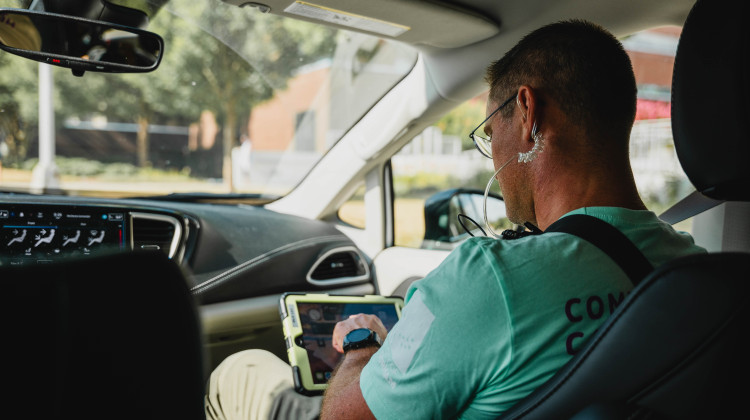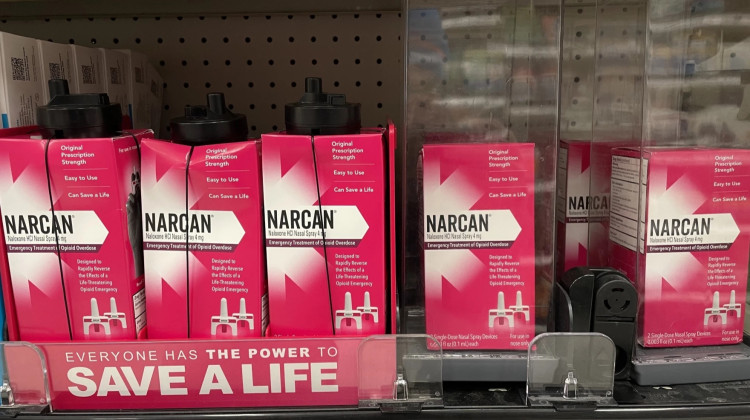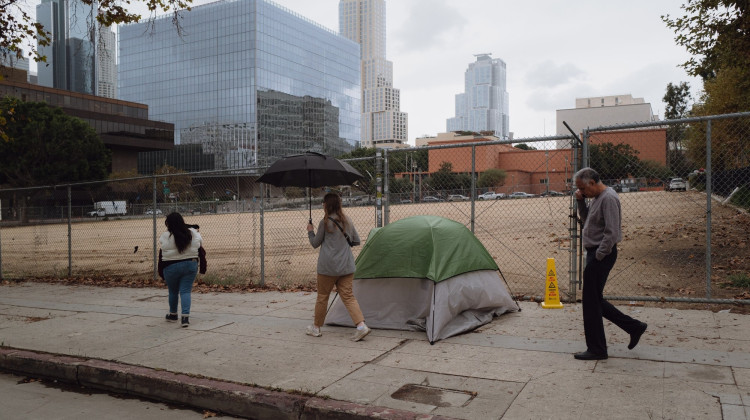
David Prater, peer support specialist, prepares to respond to a call in Durham.
Angela Hollowell / TradeoffsOne-fifth of adults in the United States have a mental illness, which makes them a lot more vulnerable to police violence. In fact, they're 16 times more likely to be killed during police encounters compared to others without mental health issues.
So, when these people are in crisis, or need help, who should they turn to? And how is the U.S. crisis response system taking care of them? That's The Checkup’s question for today.
Side Effects Public Media’s Community Engagement Specialist, Lizzy McGreevy, spoke with Ryan Levi, producer with the health policy news organization Tradeoffs and the reporter behind the new series The Fifth Branch, which explores the role of alternative crisis response teams, their successes, barriers and limitations.
This transcript has been edited for length, style and clarity.
Lizzy McGrevy: So you just produced a series called The Fifth Branch, and it's looking at the crisis response system and how it responds to people with mental illness. Can you tell us what is the fifth branch in this case?
Ryan Levi: So, most people are familiar with the standard four branches of public safety. You've got 911, answering the call, and then police, fire or EMS responding. But there are a lot of reasons that people call 911 that aren't good fits for police, fire or EMS.
So, the idea of the fifth branch is a different type of response that 911 can send out. So, this would be unarmed mental health workers who can respond to nonviolent 911 calls involving things like mental health, homelessness and addiction.
McGrevy: So, unarmed crisis response teams, that's not really a new concept. It's been around since the 1980s here in the U.S., but for some reason it feels like there hasn't been a real commitment to this mission. And I say that because we hear time and time again, about police killing people going through mental health crises. Can you talk about what your reporting found in terms of the challenges that the concept of non-police responses is facing?
Levi: Absolutely. You know, to many people, this is just a radical idea. Sending someone other than a cop, firefighter or paramedic to a 911 call just doesn't compute for some folks. They worry: Is it safe to send unarmed civilians to 911 calls?
I will say the evidence, so far, strongly suggests that it is [safe]. And of course, trying to stand up a whole new public safety branch takes a lot of resources.
But I will say, we are seeing more cities take this on. You have these programs in more than 100 communities across the country, including more than half of the country's largest cities having some kind of unarmed 911 response.

McGrevy: I am excited to say that here in Indianapolis, which is where WFYI is located, the city did launch a new crisis response team made up of clinicians, that's called Clinician Led Community Response. And that started a year ago. So, a lot of places have a form of this crisis response team, like you said, but it kind of feels “patch-worky”. How do we measure the performance or the success of these programs?
Levi: It’s a very important question. Most of these programs are just a few years old, and a lot of them still have limited hours, or only cover certain parts of town. So, that's all to say, this is still small, this is still new. The main metric that most cities use so far to kind of measure their success is how many calls they've diverted from police –– removing that chance for an arrest or a violent police interaction.
Other metrics that could tell us more are what impact these programs are having on things like arrest rates, police use of force, [and] access to long term treatment. But those are a lot harder to tease out and study because there's just a lot of things that can impact those.
So, researchers are doing that work right now in Durham and a few other cities. But that's going to take a little more time. And hopefully, we'll know more about these other impacts soon.

McGrevy: So, the full series of The Fifth Branch is out now. And you take us to Durham, N.C. You rode along 911 calls, shadowed the staff –– the whole nine yards. Why did you choose Durham? And what is something that really stuck with you as you were doing this kind of reporting?
Levi: In terms of picking Durham, it's one of the most robust programs in the country alongside places like Denver, Albuquerque, and Eugene, Ore., and they were willing to give us a lot of access, you know, all that access that you mentioned.
One thing that stood out was just how people responded to this different kind of response. You know, I sat with people, with multiple people, who were reduced to tears because they felt cared for in a way that they just never had before by a first responder.
On the other side, though, it also became clear in my time there just kind of how limited this fifth branch is and the limits of what they can do for people because the folks they're interacting with have a lot of needs –– food, money, housing, mental health care –– and all of that is in short supply. And I think it just shows how big the needs are, how many gaps there still are in our social safety net. And the limits, at least now, to how big of an impact these types of programs can make.
McGrevy: Ryan, thank you so much for this wonderful information.
The Fifth Branch is a special series by Tradeoffs and The Marshall Project that examines what it looks like when one community dramatically changes how it responds to people in crisis.
You can listen to all three episodes of The Fifth Branch now and learn more about the series at http://tradeoffs.org/thefifthbranch.
 DONATE
DONATE







 Support WFYI. We can't do it without you.
Support WFYI. We can't do it without you.